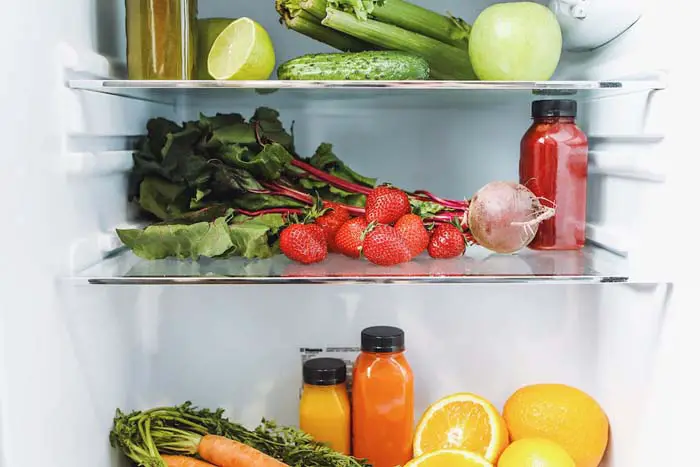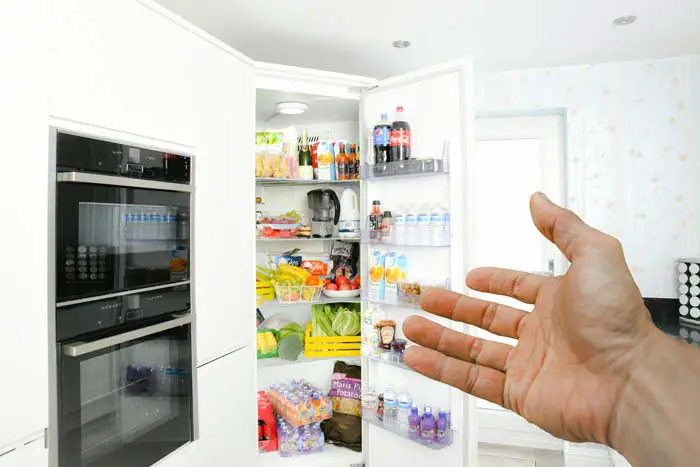Keeping your refrigerator neat offers benefits beyond just making it simpler to take stock of what you have. Storing perishables wherever you can fit them can be tempting when you need more cabinet space. However, doing so can hasten the spoilage of foods like cheese and juice. To avoid this, you should familiarize yourself with the optimal placement of your refrigerator’s many food and drink categories.
When you are thinking about arranging your refrigerator, the first thing you should do is check the temperature inside the refrigerator. Make sure it is at a level that is safe for the food inside. You can find an appliance thermometer in most places. Additionally, you may use it to set your refrigerator to a temperature of 40° or lower. You can slow down bacteria growth in your food using this temperature range.
You can start arranging after checking that the refrigerator is at the right temperature. Place certain grocery shop essentials, such as fresh produce, seafood, meats, and dairy products, in the compartments that are specifically intended for them.
Here’s how you can arrange food in your refrigerator.
Side Doors
The doors of your refrigerator tend to be warmer than the rest of the interior. Because of this, you should only keep perishable things that can withstand temperature changes on the shelves inside the refrigerator’s doors.
This is where you should store your condiments, such as dressings, mustard, ketchup, and mayonnaise. Also, you can keep non-perishable beverages like bottled soda and water.

Lower Shelves
Like the middle, the lowest shelf always frees up in your fridge. This is why it’s important to keep raw fish, poultry, and meats on the lower shelves of your fridge.
Furthermore, you can reduce the likelihood of cross-contamination. This is done by keeping poultry and raw meats below other perishables that may have been cooked to a higher temperature than the poultry and meats.
Middle Shelves
The temperature on the middle shelves of the fridge stays the coldest and is the most constant throughout the rest of the shelf.
The low temperature retards the growth of pathogenic organisms. These are the microorganisms that cause illness as well as spoilage, which causes food to become rotten. Because of this, you should store dairy goods such as cheese, eggs, and milk in that area of the refrigerator.
Upper Shelves
The upper shelves of your refrigerator are ideal for quick-grab items because of their convenient location. Leftovers and foods that don’t require any preparation before you eat them, such as those on the upper shelf, should be stored there. The higher shelves are ideal for storing leftover pizza, dips, and salads, such as potato salad and coleslaw.
Crisper Drawers
The crisper drawers in the refrigerator provide a controlled humidity environment that is most beneficial to fruits and vegetables.
Airflow is introduced into the low-humidity drawer, while the high-humidity drawer is sealed off entirely.
High Humidity
Sweet potatoes, cucumbers, lettuce, strawberries, squash, peppers, and broccoli are ethylene-sensitive vegetables and fruits. These items go in the high-humidity drawer.
Because of its airtight construction, you can store fruits and vegetables for longer without drying out. Keep vegetables and fruits that produce ethylene separate from high-producing vegetables and fruits if your refrigerator doesn’t contain these two sections.
Low Humidity
Produce ripens faster when exposed to ethylene, a gas given off by fruits and vegetables. Pears, papayas, avocados, cantaloupes, apples, kiwis, and peaches release too much ethylene. You should store them in the refrigerator’s lowest-humidity drawer. Because of how it’s constructed, air may flow into the drawer, and part of the ethylene gas can escape. This will help extend the shelf life of perishables stored inside.
Top Ten Refrigerator Organization Tips
- To avoid food contamination and unnecessary spoilage, you should never store anything hot in the refrigerator.
- Take care when handling meat.
- Regularly defrost your refrigerator to prevent ice buildup.
- While the central shelf of the refrigerator is ideal for storing most dairy products, you can use the front shelves for butter and milder cheeses.
- Keep perishable goods, like herbs and salads, away from the back of the refrigerator. Additionally, do not allow them to come into contact with it. The temperature in the very back of the refrigerator is lower. Perishable foods like these could potentially freeze and get spoiled.
- Remove tomatoes, pears, nectarines, avocados, plums, peaches, and bananas from the fridge. This is because they are ‘gas releasers’ that can hasten the spoilage of other vegetables.
- Refresh your fridge with regular cleaning. An old toothbrush might be useful for reaching into tight spaces.
- After opening, store jars of condiments, jellies, and jams in the refrigerator for optimal freshness. Cooked foods should have an adequate covering, whereas fish and raw meat should have a tightly sealed cover.
- You should keep cooked and raw foods in different kitchen areas. To prevent raw food from dripping or dropping onto cooked food and contaminating it, store cooked and ready-to-eat foods higher up in the fridge.
The best reasons to organize the refrigerator
Eating healthy is easy.
Having easy access to healthy meals is facilitated by a well-organized refrigerator. The more visible the healthy food selections in your refrigerator, the more likely you will use them. For instance, if you keep carrot sticks and apples on the same shelf, you’re more likely to grab those for a snack than to reach for something less healthy. Planning meals and making nutritious food is much simpler when your kitchen is in order. When nutritious food selections are readily available and easy to select, this can aid in maintaining a healthy diet and lifestyle.
Avoid food spoilage by maintaining a tidy refrigerator.
Keeping your refrigerator neat is another good way to save money. When everything has a home and a label, you always know what’s in the fridge and how long it’s been there. Using up perishables before they go bad is a great way to reduce wasteful food waste. In addition to saving money, limiting food waste will keep you from making as many trips to the supermarket.
A well-organized refrigerator is a time saver.
If you’re trying to figure out how to get your refrigerator in order, one of the most crucial things you can do is ensure everything has a specific spot. Label everything, use containers with see-through lids to keep things organized, and combine the same items. This will make it much simpler to obtain what you need when you require it. For this reason, it will reduce the time you waste looking for particular things.
Conclusion
Get the whole family involved in cleaning out the fridge. Make a strategy and commit to it. Put in place basic food safety regulations. Additionally, make sure all foods have their own designated space. You’ll feel better just by keeping the fridge clean and organized; it’s there to help.

